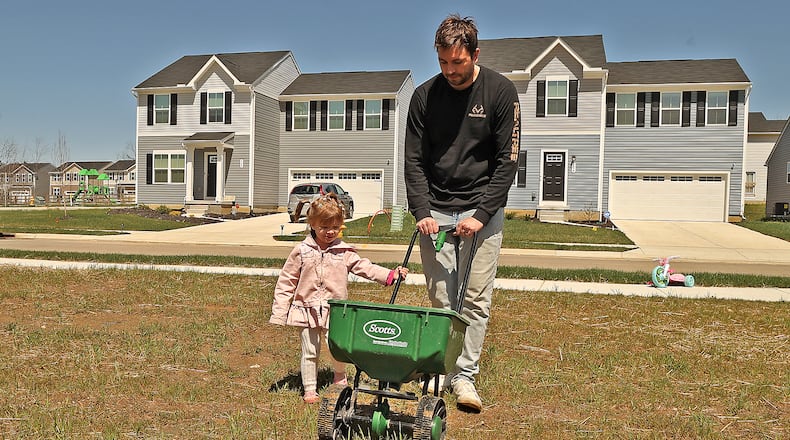The developments — one of which has been under construction since 2019 — will have a combined 1,700 single-family, multi-family and patio-style homes. The largest of the three was proposed to the Springfield City Commission two weeks ago, and it will consist of more than 1,200 units. Commissioners last week approved a plan to annex 247 acres of land from Springfield Twp. for that project, which will be located at 4025 E. National Road.
The other two developments are Bridgewater — 226 homes — on Tuttle Road and Sycamore Ridge — 258 homes — on East Leffel Lane and South Burnett Road. Land from Springfield Twp. were also annexed to Springfield for both projects.
“Growth is an exciting and challenging opportunity for our district and Springfield Township,” said Brian Kuhn, superintendent of Clark-Shawnee Local Schools. “Obviously, growth shows that we are a healthy township and a desirable place to live, and schools are a reflection of that.”
The new homes will mark the first major housing developments in the Springfield area since the early 1990s.
The National Road project, with its proposed 1,258 units, will be the largest single housing development in the city in decades should it come to fruition. It will be built on the site of the former Melody Drive-in Theatre.
Credit: JIM NOELKER
Credit: JIM NOELKER
Homeowners in the new developments will be residents of both city of Springfield and Springfield Twp. They will be eligible to vote for city commissioners and township trustees, and certain ballot issues. However, the homes will not be within the Springfield city school district.
‘An opportunity to grow our population’
Opponents of the developments unsuccessfully urged Springfield city commissioners not to approve the three annexation requests. Residents such as Melissa Baker say they’re opposed to the projects because the school district doesn’t have enough space to accommodate an influx of students. In addition, existing services and resources will be stretched even more, opponents say. They also cited difficulties in obtaining additional money in the past to build and remodel schools.
Ohio public schools are funded primarily by property taxes. About 63% of districts’ general fund revenue comes from local taxes annually — based on property values — constituting roughly $12.8 million, Kuhn said.
The reliance on property taxes as the primary source of school funding is another reason some residents are opposed to the housing developments. They say school officials will likely ask them for additional property taxes to accommodate the influx of student.
However, school districts do not always absorb all of the students already living or moving in to their boundaries, said Brian Yontz, chair of the Wittenberg University Education Department. Some of the new students could attend neighboring districts or private and charter schools, especially through school choice voucher programs, he said.
Proponents of the housing developments argue that the projects will benefit local schools in the long term because the additional homes will generate new tax revenue and lead to more economic development in the area.
“Springfield, Clark County has not seen the type of development that we are seeing today in quite some time,” Springfield City Manager Bryan Heck said. “It is an exciting time for Springfield and Clark County because it means growth. We have been on a period of population decline and this presents us an opportunity to grow our population.”
Planning for the unknown
Given the fact that the majority of the projects are still in the planning phase, there’s little information about how the new homes and the influx of students will impact the district.
It is also unclear how many new students will enroll as a result of the developments over the next several years.
Credit: Bill Lackey
Credit: Bill Lackey
In the mean time, school officials are carefully monitoring the situation and they’ll adjust their plans as more information become available.
One thing that is clear is that more students can mean new expenses or shifting of resources. The district expects to not receive full property taxes from some of the new developments. A new school was also built recently and the project was planned at a time when the district was not expecting population growth.
Two of the new developments have applied for an agreement that would reduce the school’s portion of property taxes generated from those new homes annually for 10 years.
Last year Clark-Shawnee completed a $52 million construction project that included a new pre-K through sixth-grade school building and renovations of the middle/high school.
That project had been in the works since voters approved a $37 million bond issue in August 2017 for school construction and renovations. Planning was based on state forecasted enrollment numbers.
“At that time, there was no forecasted development in our township. We built buildings on everything that was known at the time,” Kuhn said.
As of April, Clark-Shawnee has about 1,827 students affiliated with the district. But, just under 1,700 students attend Clark-Shawnee’s buildings, according to data provided by the school district.
School officials are considering reducing open enrollment applicants — students who live outside of the district but attend Clark-Shawnee schools — if there is a spike in enrollment due to the new developments.
The district currently has more than 200 open enrolled students and there is room in district buildings to accommodate new students living within its boundaries, Heck said.
Tax Increment Financing
Still, Baker, the resident who lives in the Clark-Shawnee school district and opposes the proposed development at the Melody Drive-in, says the new projects and economic incentives requested by Bridgewater and Sycamore Ridge will create an unfair tax burden.
That stems from a request for Tax Increment Financing (TIF), which has been approved for the Bridgewater development. A similar request is pending for the Sycamore Ridge.
Bridgewater built its first homes in early 2020 and since then has seen a number of new residents move in. The development is scheduled to be completed later this year and in total represents 226 new homes. Some students from Bridgewater have already enrolled into Clark-Shawnee.
The same developer, DDC management, expects to start the first phase of Sycamore Ridge, which aims to build 258 homes, also this year.
Credit: Bill Lackey
Credit: Bill Lackey
The current TIF for Bridgewater would have 25% of the property tax marked for local schools going to Clark-Shawnee for up to 10 years. After that the district would receive the full amount of those taxes. A similar agreement has been proposed for Sycamore Ridge.
Opponents argue that given the TIF agreement that’s in place, the school district may be forced to ask voters in the near future to pay for another new building or an increase in operational expenses due to less property taxes coming from new homes if the district’s enrollment balloons.
But in general there are a number of ways that school districts can handle challenges associated with an increased enrollment, said Yontz. For example, school districts within the state of Ohio have the option to develop a virtual component, which would include remote learning, he said.
“You can educate a much larger population that way, and they are not using some of the fixed cost within a school building, like toilet paper, like lights, seats on the bus. But those students could still be counted in the headcount for enrollment,” Yontz said.
He noted that is not a preferred method for a lot of districts, but could be a potential solution, nonetheless.
Another option would be to develop some type of temporary facilities that would be used by the school district. That would be at cost to the district but would be another way to deal with an influx of an enrollment.
The impacts of population growth including to local schools is often not concentrated within one area or district, au said.
“I can see that any influx in population will be spread out to other school districts, including private charter schools,” he noted.
He added that some of those students could be going to Catholic Central or Emanuel Christian or the Global Impact Stem Academy and could take advantage of voucher programs.
“Development is good for all of us obviously, but I don’t think just because a development is in a certain school district, it automatically means that the entire burden will fall on that particular school district,” he said.
Managing existing resources
As Clark-Shawnee officials prepare for the future, requests for new funding could come sooner than originally planned, depending on what the increase in students would look like for the district, Kuhn said.
In the meantime, district officials say they plan to manage existing resources the best they can.
Clark-Shawnee does have a substitute levy on the May ballot. However, it would not constitute any new taxes to residents and instead combines two existing emergency levies into one ballot issue defined as a substitute combined renewal. The 12.1 mill-levy would generate about $4.7 million a year, the total of what the two existing levies bring into the district.
If approved, that money would go to the district’s general fund to pay for operating services such as supplies, utilities, salaries, materials and programs.
In terms of the TIF agreement being sought out by the Sycamore Ridge development, Springfield city officials have put in place something new that would generate more revenue to the schools.
If city commissioners approve the agreement, it will create what is known as a New Community Authority, and generate an additional 4 mills of property tax in that development.
That would result in 2 mills going to Clark-Shawnee and the other 2 going to Springfield Twp. during the 10 year period of the TIF agreement. Commissioners are expected to approve the agreement in May.
“We have tried to work to find ways to help offset some of the losses (the district) experienced through the TIF period by introducing this new community authority,” Heck said, noting that was a result of the city’s relationship with the school district.
About the Author





